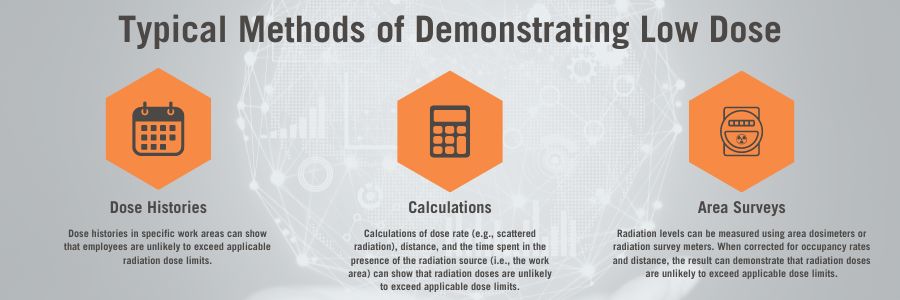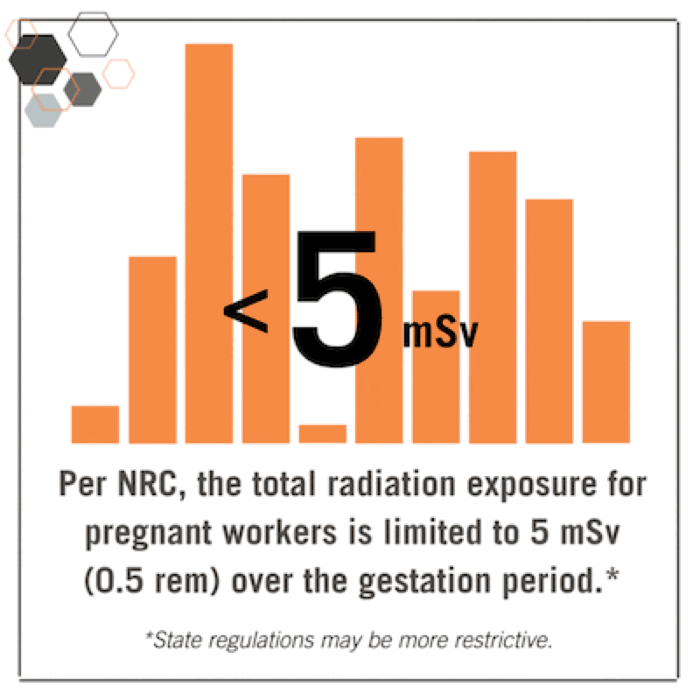
4 Reasons Why Dosimeters Are Needed in Low Exposure Scenarios
In some veterinary and medical clinics, dental offices, laboratories, and industrial settings, the use of dosimeters is assumed to be unnecessary due to low exposure and no state or federal requirements to use them. While regulations may not require the use of dosimeters to monitor radiation exposure in the workplace, dosimeters are a wise investment.
Why Doesn’t Everyone Wear Dosimeters?
Certain federal and state regulations allow employees to work with sources of radiation without dosimeters. However, the employer must demonstrate that radiation doses will not exceed 10% of the applicable limits. Check your state’s regulations as the applicable limits may be lower.
Typically, the dose to employees is demonstrated to be less than applicable limits using one of these three methods:
- Dose Histories – Dose histories in specific work areas can show that employees are unlikely to exceed applicable radiation dose limits.
- Area Surveys – Radiation levels can be measured using area dosimeters or radiation survey meters. When corrected for occupancy rates and distance, the result can demonstrate that radiation doses are unlikely to exceed applicable dose limits.
- Calculations – Calculations of dose rate (e.g., scattered radiation), distance, and the time spent in the presence of the radiation source (i.e., the work area) can show that radiation doses are unlikely to exceed applicable dose limits (NRC NUREG-1556, Volume 9, Revision 3, Appendix M).

The problem with reliance on past dose histories, area surveys, and calculations is that they change over time. When they do, a reassessment of the area or the scenario is necessary but often forgotten.
Over-reliance on what others have evaluated in the past can result in a false sense of security. An inspector would be correct to ask, “That was the estimated dose then, what is the dose now?”
Inspections are Inevitable
Workplace hazards exist in every industry, and inspections are inevitable. They vary in scope and frequency based on the risks to employees and the federal, state, or accreditation agency that regulates specific workplace hazards.
During routine inspections, an inspector who encounters a radiation hazard may ask about the employees who are routinely or potentially exposed. Without personal dosimeter data (i.e., dose), it is often assumed that employees are not exposed to the extent that dosimeters are required. Even with data from the manufacturer of the radiation source or the installer, the dose to employees at present may have changed.
- Has the radiation source been replaced or moved since it was initially purchased or installed?
- Is the radiation source used more frequently today than it was initially?>
- Has maintenance been performed that could affect the intensity of radiation from the source?
- Have new sources of radiation or modalities been added to the facility (e.g., a cephalometric or cone-beam CT imaging system in a dental clinic)?
- Do employees work at other facilities or companies with sources of radiation?
Federal and state regulations require that the dose an individual may receive in the current year from all sources of employment where the individual's assigned duties involve exposure to sources of radiation are considered.
In addition to demonstrating regulatory compliance, dosimetry results can show that an effective ALARA program has been implemented. If no one is monitored, how can you demonstrate that the dose is ALARA? If an accident or incident occurs in an area where sources of radiation are used or stored, area dosimeter and/or personal dose results are vital.

Accidents and Incidents Can Occur
When accidents or incidents occur in areas where sources of ionizing radiation are used or stored, dose results can provide first responders and healthcare providers with information concerning their safety.
Unless real-time dosimeters are being used, dose data for an accident or incident would not be immediately available. However, historical data can show that an accident scenario would be unlikely to result in risks to responder safety or excessive radiation dose(s) to the employees involved. Area dosimeters and personal dosimeters present or worn during the accident or incident can be sent to Landauer overnight for immediate analysis and the results known within one business day (two for neutron).
Dose data from area dosimeters and personal dosimeters can also be used to estimate the exposure in adjacent areas and to non-radiation workers. Dose results can reduce the potential for regulatory violations in the event of an accident or incident-based inspection. Dose results can also limit corporate and personal liability in the event of a lawsuit.
Reduced Limits for Pregnant Workers
The low dose historically received by radiation workers in a given workplace scenario may not require the use of dosimeters. However, declared pregnant radiation workers require them.

Employees should be informed about the potential risks to their pregnancies in the workplace. When radiation workers declare their pregnancy in writing, their employer must ensure that radiation exposure is limited to 5 mSv (0.5 rem) over the gestation period and relatively uniform (i.e., a uniform monthly exposure rate). State regulations are often more restrictive.
Achieving this dose reduction is a cooperative effort between the employer and employee. Given the reduced dose limits for declared pregnant radiation workers, it is necessary to provide them with dosimeters. It is also necessary for the employer to determine (or estimate) the dose to the growing embryo/fetus from the estimated date of conception until the time the pregnancy was declared. Area or preferably personal dosimeter results are vital in this estimation.
It is prudent to monitor employees of child-bearing age who are exposed to other than background radiation in the workplace (i.e., radiation workers). A best practice would be to monitor all radiation workers.
Dosimeters Provide Peace of Mind
Area and personal dosimeters provide vital information about the presence or absence of radiation in the workplace. Monitoring an employee’s exposure to radiation in the workplace tells them that you are concerned for their safety, like the Boy Scout’s motto “Be Prepared.”
Dose results prepare us to answer the questions…
- Is it safe?
- Is it ALARA?
- Am I in compliance?
- Have I covered all the bases?
That last question is sufficient justification to establish a dosimetry program. The answers to these questions serve as insurance when you need it. Better to have it and not need it than to need it and not have it.
In addition to your state’s regulations and guidance, information can be obtained from the Occupational Health and Safety Administration (OSHA) website. The OSHA’s website provides example exposure scenarios and suggestions for controls and prevention.
If you’d like to talk to us about monitoring your workers, please fill out the contact form and a representative will be in touch!

